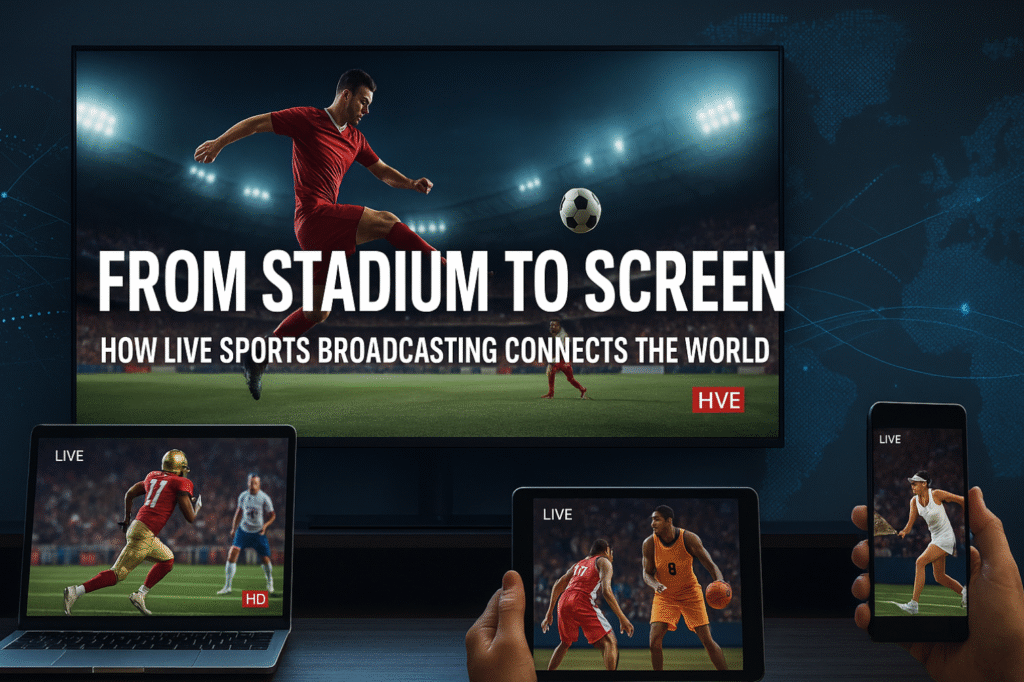
Sports broadcasting has always been more than just a medium — it’s a bridge that connects millions of fans across continents. From local radio commentaries to high-definition live streams, the evolution of how we watch and experience sports has reshaped not only fan culture but the entire global entertainment industry.
As we move deeper into the digital age, the line between stadium and screen continues to blur. Fans are no longer passive spectators; they’re part of a worldwide, interactive community bound by technology, emotion, and shared excitement.
The evolution of live sports broadcasting technology
Sports broadcasting has evolved dramatically over the last century. In the early 20th century, sports reached fans through radio — a purely auditory experience that relied on imagination. Television changed everything in the 1950s, bringing visuals into living rooms and transforming players into icons.
Fast forward to today: ultra-high-definition (4K and 8K) video, drone footage, and augmented reality (AR) overlays deliver every movement and emotion in microscopic detail. Live streams are now accessible on smartphones, tablets, and smart TVs — allowing fans to follow their favorite teams from anywhere, at any time.
Broadcasters and digital platforms like https://yjtv114.com are at the forefront of this revolution, making high-quality live streaming of global events more accessible than ever. By combining powerful servers, AI-driven optimization, and multilingual commentary, they ensure that no fan misses a moment of the action.
How live broadcasting creates a global fan experience
The magic of sports broadcasting lies in its ability to unite people. A football fan in Seoul can cheer for the same team as someone in Madrid, and a baseball enthusiast in New York can share live reactions with friends in Tokyo. This real-time connectivity has transformed sports into a shared global ritual.
Social media integration has further enhanced this sense of connection. Fans engage through live chats, reactions, and interactive polls during broadcasts, turning a simple game into a communal experience. Modern streaming platforms allow viewers to switch between camera angles, follow specific players, or replay key moments instantly.
The rise of interactive viewing means fans no longer just watch — they participate. Whether it’s voting for “Man of the Match” or sharing clips seconds after a goal, the fan experience has become more immersive and inclusive than ever before.
Cloud technology and AI: the hidden engines behind global streaming
Behind every smooth live stream lies a complex technological ecosystem. Cloud computing enables broadcasters to handle massive traffic spikes during major events like the World Cup or NBA Finals. Instead of relying on local servers, modern platforms distribute content through global networks that reduce latency and maintain quality even under heavy demand.
Artificial intelligence also plays a crucial role. AI algorithms predict network congestion, optimize bandwidth distribution, and automatically adjust video quality for each viewer’s device. These systems ensure that fans on opposite sides of the world receive the same seamless experience — no buffering, no lag.
AI commentary systems are also emerging, capable of generating live insights, statistics, and tactical breakdowns in real time. This innovation brings analytical depth to broadcasts that once required large production teams.
The rise of digital-first broadcasting platforms
Traditional television still holds influence, but digital-first streaming platforms have captured the attention of the next generation. Sites like BluemonkeySports.com demonstrate how online accessibility can rival — and even surpass — traditional broadcast networks.
Unlike cable subscriptions with regional restrictions, digital platforms offer global coverage, often free or at minimal cost. Viewers can enjoy high-definition sports streams without hardware limitations, and broadcasters can reach audiences in emerging markets previously excluded from major leagues.
Moreover, these platforms promote lesser-known sports and leagues, giving visibility to athletes and teams who might never appear on traditional TV. This inclusivity fosters diversity and expands the global sports ecosystem beyond mainstream competitions.
How technology strengthens emotional connection to sports
At its core, sports broadcasting is about emotion — the shared joy of victory, the heartbreak of defeat, and the anticipation of what happens next. Technology amplifies these emotions by bringing fans closer to the action.
Slow-motion replays capture every detail of a goal or dunk. High-definition audio makes viewers feel the roar of the crowd and the tension on the field. Virtual reality (VR) and 360° cameras even allow fans to “sit” courtside or pitch-side without leaving home.
By combining human storytelling with digital immersion, modern broadcasting ensures that every viewer — whether in a small café or on a city rooftop — feels connected to the moment.
Global broadcasting rights and the power of accessibility
The internationalization of sports has led to fierce competition for broadcasting rights. Leagues like the English Premier League, NBA, and MLB have built massive followings thanks to worldwide TV deals and online streaming agreements.
However, accessibility remains the defining factor of the modern era. Platforms that offer free or low-cost streams are enabling millions of new fans to engage with their favorite sports. The democratization of sports access through the internet is creating new audiences, inspiring young athletes, and expanding the cultural influence of sports globally.
As technology continues to evolve, this accessibility will only deepen — ensuring that sports remain a truly universal language.
The future of global sports broadcasting
Looking ahead, the next phase of sports broadcasting will likely combine AI automation, 5G networks, and immersive technologies. Fans may soon experience fully interactive broadcasts, where data overlays, instant analytics, and camera switching are all controlled through gestures or voice commands.
With 5G reducing latency to near zero, live events will feel instantaneous. Cloud-based systems will allow multiple matches or angles to stream simultaneously, and VR integration will make “being there” virtually indistinguishable from reality.
As the world becomes increasingly connected, the power of sports broadcasting will continue to unite fans across cultures and continents. From a crowded stadium to a quiet living room, every cheer, every goal, and every heartbeat will echo globally — reminding us that in sports, we are all part of the same game.
